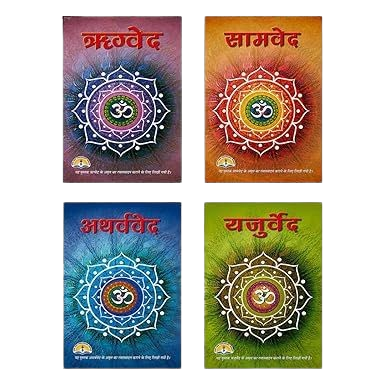The Four Vedas – Foundation of Hindu Wisdom
The Four Vedas – Foundation of Hindu Wisdom

The Four Vedas – Foundation of Hindu Wisdom
The Vedas are the most ancient and sacred scriptures of Hinduism, regarded as apauruṣeya (not of human origin, but revealed to sages through divine inspiration). They form the foundation of Sanātana Dharma, preserving the spiritual, ritualistic, and philosophical heritage of ancient India. The Vedas are written in Vedic Sanskrit and are divided into four main collections: the Rigveda, Yajurveda, Samaveda, and Atharvaveda. Each Veda is further divided into four parts: the Samhitas (hymns), Brahmanas (ritual instructions), Aranyakas (forest treatises), and Upanishads (spiritual wisdom).
1. Rigveda (ऋग्वेद)
The Rigveda is the oldest and most important Veda, consisting of 1,028 hymns arranged into ten mandalas (books). These hymns praise natural forces and deities such as Agni (fire), Indra (thunder and rain), Varuna (cosmic order), Surya (sun), and Ushas (dawn). The Rigveda explores themes of creation, cosmic order (ṛta), devotion, and philosophical questions. It includes famous hymns like the Gayatri Mantra, the Nasadiya Sukta (Hymn of Creation), and the Purusha Sukta (Cosmic Being). It reflects the earliest stage of Indian spiritual thought, blending nature worship with profound philosophy.
2. Yajurveda (यजुर्वेद)
The Yajurveda is a practical manual of rituals and sacrifices, guiding priests on the correct performance of yajnas. Unlike the Rigveda, which is mostly hymns, the Yajurveda combines mantras with prose instructions. It is divided into two versions: the Shukla (White) Yajurveda, which presents its content clearly, and the Krishna (Black) Yajurveda, which mixes hymns with commentary. It includes rituals such as the Agnihotra (fire offerings), Somayajna (Soma sacrifice), and the Ashvamedha (horse sacrifice). The Yajurveda also contains the Isha Upanishad, which teaches the balance of worldly enjoyment and spiritual renunciation, making this Veda both a ritual guide and a source of deep philosophy.
3. Samaveda (सामवेद)
The Samaveda is known as the “Veda of Chants and Melodies.” Most of its verses are borrowed from the Rigveda, but they are set to musical patterns for chanting during rituals. The Samaveda provides the foundation of Indian classical music and dance, with its hymns meant to be sung in three tones—high, medium, and low. Though it is the shortest Veda, with about 1,875 verses, its emphasis lies in the power of sound, rhythm, and vibration as a means of connecting with the divine. The Samaveda transforms ritual into a spiritual and artistic experience, showing that devotion can be expressed not only through prayer but also through music and melody.
4. Atharvaveda (अथर्ववेद)
The Atharvaveda is unique among the four, often called the “Veda of Knowledge and Everyday Life.” It contains hymns, charms, and spells for health, protection, prosperity, and social harmony. Many verses focus on healing diseases, driving away evil forces, ensuring success in love, and bringing peace within families and communities. It is also one of the earliest sources of Ayurveda (Indian medicine), with hymns on the use of herbs and natural remedies. Alongside these practical concerns, the Atharvaveda also includes profound reflections on the soul (ātman), creation, death, and immortality, showing the unity of worldly well-being and spiritual pursuit.
✨ Significance of the Vedas
Together, the four Vedas represent the complete vision of life—ritual, devotion, music, healing, philosophy, and liberation. They are not merely religious texts but a treasury of knowledge that shaped Indian culture, philosophy, science, and spirituality. The Rigveda inspires inquiry, the Yajurveda teaches sacred action, the Samaveda elevates sound into worship, and the Atharvaveda unites daily life with spiritual truth. Even after thousands of years, the Vedas continue to guide seekers, preserving the eternal wisdom of Sanātana Dharma.
























































